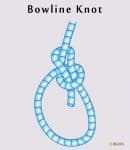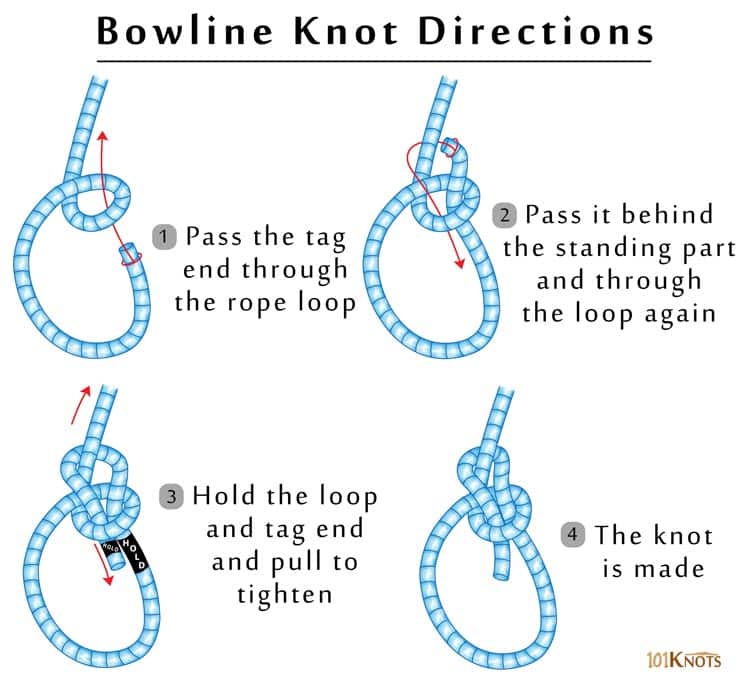Tying a Bowline Knot

Bowline Knot
Definition
The bowline (pronunciation "boh-lin") is a knot that can itself be tied at the middle of a rope making a fixed, secure loop at the end of the line. It retains about 60% of the line strength and has a knot efficiency of 77%. You can learn this basic knot taught at ranger schools by the aid of the below printable diagram with instructions.
History and Etymology
The use of its name (sometimes spelled as two separate words, bow line) dates back to the Age of Sail (1571-1862, approximately). At that time, it referred to a rope on a square-rigged ship that held the edge of a square sail towards the bow and into the wind protecting it from sudden unexpected movements. The knot, as we know it now, was first mentioned in 1961 in the book A Sea Grammar by John Smith. Its discovery on the rigging of a solar ship belonging to the Egyptian Pharaoh Khufu, during an excavation in 1954 testifies its ancient origin.
How to Tie a Bowline Knot

How to Tie a Bowline Knot
Tips
- The tying procedure can be remembered by the bunny mnemonic where the loop made in step 1 is imagined as a rabbit hole, the standing part as a tree trunk and the tag end, a rabbit. While tying, the bunny comes up the hole, goes round the tree and back down the hole. You can teach it to children with the poem, "Up through the rabbit hole, round the big tree; down through the rabbit hole and off goes he."
- It can be tied with one hand, in case you are injured or have other issues.
- It is dangerous to load the knot sideways as it may lead to slippage while rappelling, etc.
- In step 1, the end is passed through the loop in a way resembling the making of an overhand knot.
- You can interlock the loops of two bowlines to join two ropes. The sheet bend can also do the same, but temporarily.
- It can be tied in the slip knot method where the standing part is passed through the loop of step 1, instead of the tag end, forming a bight through which the end is passed and pulled tight. This quicker version is known as the snap bowline.
Types of Bowline Knots
- Spanish bowline knot – The rescue knot creates two loops.
- French bowline knot – Also known as the Portuguese bowline, it forms two loops that are adjustable in size, unlike the Spanish bowline. It is used in making a temporary Bosun's chair.
- Running bowline knot – Forms a sliding loop.
- Double bowline knot – It is a basic bowline with an extra turn around the bight made in step 3.
- Triple bowline knot – Forms three loops that can be fastened to multiple anchor points.
- Water bowline knot – It is a bowline with an extra half hitch.
- Bowline on a bight – It is made with a bight of rope.
- Yosemite bowline – It is a bowline locked with a Yosemite finish.
- Bowline on a coil knot – For attaching tag lines to litters in both vertical and horizontal configurations.
- Left-handed bowline – In this variation, the tag end is wrapped in the opposite direction around the standing part as shown in step 2. It is also known by the names Dutch bowline (owing to its use by the Dutch navy) and cowboy bowline.
- Eskimo bowline – The tag end is wrapped around a part of the bigger loop instead of the standing end that helps it from being shaken loose, a weakness of the standard bowline.
Advantages | Disadvantages |
|
|
Uses
- To tie a mooring line around a tree, post, pole, anchor, ring, ladder, or any other object.
- Boating, sailing (for example, tying a jib sheet to the clew of a jib), fishing.
- It is thrown and tied around the waist for rescue operations, firefighting.
- By boy scouts, linemen.
- For attaching soft strings to a banjo, tree climbing, hanging hammocks using guy lines, tying a horse safely, connecting a handle line to a kite.
How Do You Tie a Bowline Knot – Video
Alternatives
- Figure 8 follow through – More secure.
- Clove hitch – Weaker.
Similar Knot
- Flying bowline knot – It is a quick and easy knot that is used in rescue operations.
Source: https://www.101knots.com/bowline-knot.html